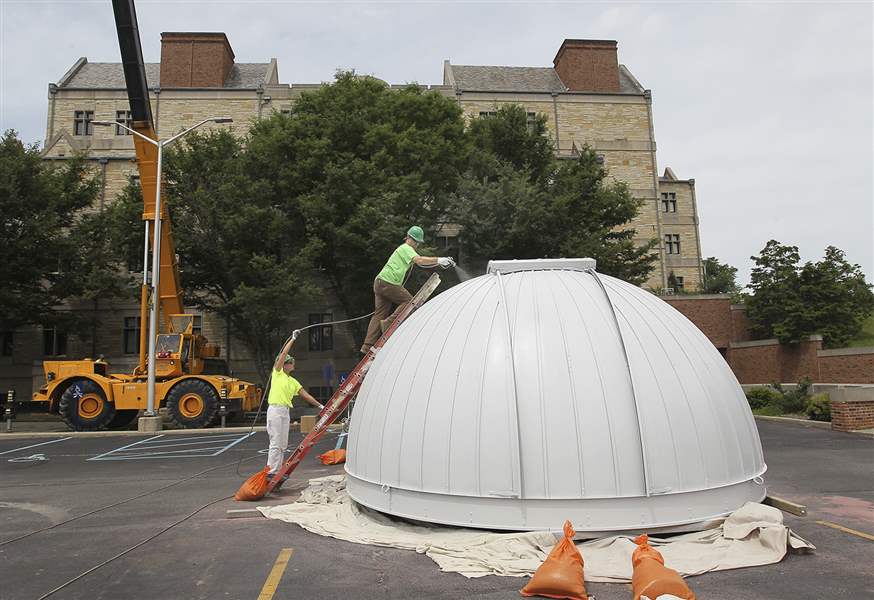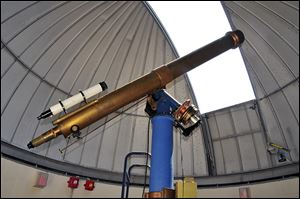
UT observatory to house new telescope
Instrument has greater capability
6/26/2015
Lucy Ruggiero holds the hose to the paint sprayer as Jeremy Baum paints the dome of the Brooks Observatory, which was removed from the top of McMaster Hall on the University of Toledo campus.
THE BLADE/DAVE ZAPOTOSKY
Buy This Image

The six-inch Brashear refracting telescope, on UT’s campus since 1931, is in the process of being replaced by a new telescope for the Brooks Observatory.
For decades, stargazers observed the night sky by peering through a more than century-old brass telescope mounted six stories above the University of Toledo campus.
The refracting telescope designed by American astronomer John Alfred Brashear had a long-held place of prominence at the Brooks Observatory, atop McMaster Hall, until its recent removal.
The observatory is undergoing an $80,000 renovation, the centerpiece of which is a new telescope with the capability to see far dimmer objects and easily track their movements.
The updates required removing the observatory’s dome. This week, the round white cap rested in a parking lot next to McMaster Hall. Crews added a fresh coat of paint to the dome, and a crane lifted materials to workers on top of the building.
The renovations are expected to be complete by fall, when officials plan to reopen the observatory to public viewing using the new telescope.
“It will let us see a lot more things. It will allow us to see those same things in a lot more detail,” said Alex Mak, associate director for UT’s Ritter Planetarium. “It’s going to revolutionize our public observing program.”
The Brooks Observatory was established in 1987. The Brashear telescope, an instrument dating to about the turn of the century and gifted to the university, has been on campus since 1931.
It first perched at University Hall, where it remained until the late 1970s when it was put into storage. It later moved into the Brooks Observatory, built with funds donated by its namesake, the late astronomy professor Helen Brooks and her husband, Elgin. They gave generously to support astronomy at UT, and the observatory’s current renovation is partly funded through an endowment established by the couple.
The College of Natural Sciences and Mathematics also contributed to the project’s cost.
The Brooks Observatory hosts regular public viewings and is used by undergraduate students and community groups. When it reopens, it will resume that schedule.
Next door, the Ritter Observatory boasts a powerful reflecting telescope that is used primarily by faculty and graduate students for research. Weather permitting, the public can visit the Ritter Observatory on the first Friday of every month following a program at the Ritter Planetarium.

Lucy Ruggiero holds the hose to the paint sprayer as Jeremy Baum paints the dome of the Brooks Observatory, which was removed from the top of McMaster Hall on the University of Toledo campus.
The Brashear telescope would have been a considered a “high-end, amateur telescope” when it was installed at UT, Mr. Mak said. It is too small to conduct serious research.
Its replacement is a Celestron EdgeHD 14 with the ability to collect about 5.4 times more light than the old instrument, what Mr. Mak described as “a significant upgrade.”
The new telescope, held steady on a new mount, can be used to take photographs of the heavens. A computerized database of several hundred thousand objects will help users quickly locate what they want to view in the vast sky.
“The old telescope you manually lined up, and you had to really understand the sky and know where things were. And, there was a certain amount of luck that went along with it, and it took people a good year or two to really learn how to use a telescope,” Mr. Mak said.
The new instrument will be “far superior” and open up a broader range of things to see in the night sky, said Cody Gerhartz, a UT doctoral student who helps with public observation nights.
“You have no idea how excited I am to have a brand new telescope because I’m usually the one that has to run the old telescope and it’s very tedious,” he said.
The new telescope equipment costs about $20,000, a price that includes optics, mount, and a hydraulic pedestal it will be placed on.
The tube measures just under three feet long, compared with the roughly seven feet in length of the old telescope, Mr. Mak said.
He envisions developing an intermediate-level astronomy laboratory course that would utilize the new instrument. Science education majors and others interested in a course more advanced than the introductory level course could benefit from the real-world experience of learning to use the Celestron.
Renovations include making the observatory building a couple of feet shorter to accommodate the new telescope’s sightlines.
The old telescope has been placed in storage and possibly will be displayed in the future.
Contact Vanessa McCray at: vmccray@theblade.com or 419-724-6065, or on Twitter @vanmccray.